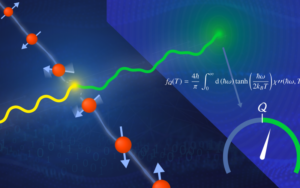
The team – including researchers from ORNL, Helmholtz-Zentrum Berlin, the Technical University of Berlin, Institut Laue-Langevin, Oxford University and Adam Mickiewicz University – tested three entanglement witnesses using a combination of neutron scattering experiments and computational simulations. Entanglement witnesses are techniques that act as data analysis tools to determine which spins cross the threshold between the classical and quantum realms.
First introduced by John Stewart Bell in the 1960s, entanglement witnesses confirmed that the quantum theory questioned by other scientists had been correct. Bell’s technique relied on detecting one pair of particles at a time, but this approach is not useful for studying solid materials composed of trillions and trillions of particles. By targeting and detecting large collections of entangled spins using new entanglement witnesses, the team extended this concept to characterize solid materials and study exotic behavior in superconductors and quantum magnets.
To ensure that the witnesses could be trusted, the team applied all three of them to a material they knew to be entangled because of a previous spin dynamics study. Two of the witnesses, which are based on Bell’s approach, adequately indicated the presence of entanglement in this one-dimensional spin chain – a straight line of adjacent spins that communicate with their neighbors while disregarding other particles – but the third, which is based on quantum information theory, fared exceptionally well at the same task.
“The quantum Fisher information, or QFI, witness showed a close overlap between theory and experiment, which makes it a robust and reliable way to quantify entanglement,” said Allen Scheie, a postdoctoral research associate at ORNL and a lead author of the team’s proof-of-concept paper published in Physical Review B.
Because fluctuations in a material that appear to be quantum in nature can be caused by random thermal motion, which only vanishes at absolute zero on the temperature scale, most modern methods cannot distinguish between these false alarms and actual quantum activity. The team not only confirmed the theoretical prediction that entanglement increases as temperature decreases but also successfully differentiated between classical and quantum activity as part of the most comprehensive QFI demonstration since the technique was proposed in 2016.
“The most interesting materials are full of quantum entanglement, but those are precisely the ones that are the most difficult to calculate,” said ORNL neutron scattering scientist Alan Tennant, who leads a project focused on quantum magnets for the Quantum Science Center, or QSC, a DOE National Quantum Information Science Research Center headquartered at ORNL.
Previously, the challenge of quickly identifying quantum materials presented a significant roadblock to the center’s mission, which involves exploiting entanglement to develop novel devices and sensors while advancing the field of quantum information science. Streamlining this process with QFI allows QSC researchers to focus on harnessing the power of substances such as rare phases of matter called quantum spin liquids and materials that do not resist electricity called superconductors for data storage and computing applications.
“The power of QFI comes from its connection to quantum metrology, in which scientists entangle multiple quasiparticles to shrink uncertainty and obtain extremely precise measurements,” Scheie said. “The QFI witness reverses this approach by using the precision of an existing measurement to determine the minimum number of particles each spin is entangled with. This is a powerful way to reveal quantum interactions, which means that QFI is really applicable to any quantum magnetic material.”
Having established that QFI could correctly categorize materials, the team tested a second one-dimensional spin chain, a more complex material featuring anisotropy, which is a property that causes spins to lie in a plane rather than rotating at random. The researchers applied a magnetic field to the spin chain and observed an entanglement transition, in which the amount of entanglement fell to zero before reappearing. They published this finding in Physical Review Letters.
To achieve these results, the researchers studied both spin chains using neutron scattering and then analyzed legacy data from experiments conducted decades ago at the ISIS Neutron Source in England and the Institut Laue-Langevin in France along with new data from the Wide Angular-Range Chopper Spectrometer located at the Spallation Neutron Source, a DOE Office of Science user facility operated by ORNL. They also ran complementary simulations to validate the results against idealized theoretical data.
Neutrons, which Tennant describes as “beautifully simple,” are an ideal tool for probing the properties of a material because of their neutral charge and nondestructive nature.
“By studying the distribution of neutrons that scatter off of a sample, which transfers energy, we were able to use neutrons as a gauge to measure quantum entanglement without relying on theories and without the need for massive quantum computers that don’t exist yet,” Tennant said.
According to the team, this combination of advanced computational and experimental resources provided answers about the nature of quantum entanglement originally asked by the founders of quantum mechanics. Scheie expects that QFI calculations are likely to become part of the standard procedure for neutron scattering experiments that could eventually characterize even the most mysterious quantum materials.
The researchers received support from the DOE Office of Science, DOE’s Scientific Discovery through Advanced Computing program, the QSC, ORNL’s Laboratory Directed Research and Development program, the Center for Nanophase Materials Sciences – a DOE Office of Science user facility located at ORNL – and the European Research Council under the European Union Horizon 2020 Research and Innovation Programme.
UT-Battelle manages ORNL for DOE’s Office of Science, the single largest supporter of basic research in the physical sciences in the United States. DOE’s Office of Science is working to address some of the most pressing challenges of our time. For more information, visit energy.gov/science. –
Source: Elizabeth Rosenthal, ORNL



























































